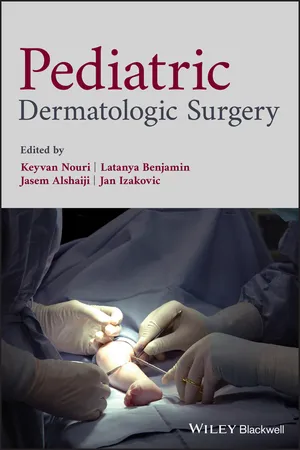
Pediatric Dermatologic Surgery
- English
- ePUB (mobile friendly)
- Available on iOS & Android
Pediatric Dermatologic Surgery
About This Book
A complete guide to the surgical techniques used to treat childhood skin conditions
Recent advances have expanded the role of pediatric dermatologic surgery in both specialist and primary care settings. However, such surgeries can pose unique challenges to trainees and experienced practitioners alike. Procedures are carried out under local anesthesia and can be a source of distress and concern among young patients. Moreover, child's skin poses its own set of complicating factors, making the business of performing these procedures especially delicate and precise.
This bookprovides a step-by-step primer on invasive and non-invasive treatments of childhood skin disorders, offering concise and clearly illustrated guidance on current methods and best practices. Addressing conditions' effects, the impact of recent developments in their treatment, the ethics of operative procedures on children, and multiple treatment options for childhood dermatologic disease, Pediatric Dermatologic Surgery is an indispensable resource for trainee dermatologists and pediatricians, as well as practicing specialists.
Frequently asked questions
Information
1
The Embryogenesis of the Skin
1.1 Introduction
1.2 Stages of Skin Development
1.2.1 Embryonic Stage (Specification)
1.2.1.1 Epidermis
1.2.1.2 Dermis
1.2.1.3 Dermoepidermal Junction (DEJ)
Table of contents
- Cover
- Table of Contents
- List of Contributors
- 1 The Embryogenesis of the Skin
- 2 Basic Structure and Function of the Neonatal, Infantile, and Childhood Skin
- 3 Approach to the Child as a Patient
- 4 Preoperative and Postoperative Care of Children Undergoing Pediatric Dermatology Procedures
- 5 The Pediatric Surgical Tray
- 6 Anesthesia for Children
- 7 Skin Biopsy Techniques
- 8 Common Pediatric Dermatologic Surgery Procedures
- 9 Suturing Techniques
- 10 Wound Closure Technique
- 11 Wound Closure Material
- 12 Dressings
- 13 Nail Surgery
- 14 Complications of Surgery and Invasive Procedures
- 15 Improving Scars
- 16 Special Dermatologic Surgery
- 17 Lasers for Vascular Lesions
- 18 Lasers for Scars and Striae
- 19 Lasers for Acne
- 20 Laser for Verrucae
- 21 Lasers and Lights for Onychomycosis
- 22 Lasers for Pigmented Lesions
- 23 Lasers for Tattoos
- 24 Lasers for Hair Removal
- 25 Lasers for Other Specific Dermatologic Disorders
- 26 Medical Ethics and Bioethics in Pediatric Dermatology
- Index
- End User License Agreement